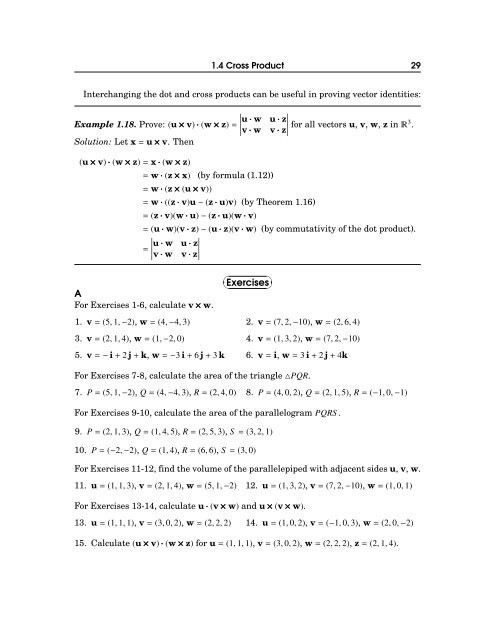Michael Corral: Vector Calculus
Michael Corral: Vector Calculus
Michael Corral: Vector Calculus
Create successful ePaper yourself
Turn your PDF publications into a flip-book with our unique Google optimized e-Paper software.
1.4 Cross Product 29<br />
Interchanging the dot and cross products can be useful in proving vector identities:<br />
Example 1.18. Prove: (u×v)·(w×z)=<br />
u·w u·z<br />
∣v·w v·z<br />
∣ for all vectors u, v, w, z in3 .<br />
Solution: Let x=u×v. Then<br />
(u×v)·(w×z)=x·(w×z)<br />
= w·(z×x) (by formula (1.12))<br />
= w·(z×(u×v))<br />
= w·((z·v)u−(z·u)v) (by Theorem 1.16)<br />
= (z·v)(w·u)−(z·u)(w·v)<br />
= (u·w)(v·z)−(u·z)(v·w) (by commutativity of the dot product).<br />
=<br />
u·w u·z<br />
∣v·w v·z<br />
∣<br />
A<br />
For Exercises 1-6, calculate v×w.<br />
☛ ✟<br />
✡Exercises<br />
✠<br />
1. v=(5,1,−2), w=(4,−4,3) 2. v=(7,2,−10), w=(2,6,4)<br />
3. v=(2,1,4), w=(1,−2,0) 4. v=(1,3,2), w=(7,2,−10)<br />
5. v=−i+2j+k, w=−3i+6j+3k 6. v=i, w=3i+2j+4k<br />
For Exercises 7-8, calculate the area of the triangle△PQR.<br />
7. P=(5,1,−2), Q=(4,−4,3), R=(2,4,0) 8. P=(4,0,2), Q=(2,1,5), R=(−1,0,−1)<br />
For Exercises 9-10, calculate the area of the parallelogram PQRS.<br />
9. P=(2,1,3), Q=(1,4,5), R=(2,5,3), S= (3,2,1)<br />
10. P=(−2,−2), Q=(1,4), R=(6,6), S= (3,0)<br />
ForExercises11-12, findthevolumeoftheparallelepipedwithadjacentsidesu, v, w.<br />
11. u=(1,1,3), v=(2,1,4), w=(5,1,−2) 12. u=(1,3,2), v=(7,2,−10), w=(1,0,1)<br />
For Exercises 13-14, calculate u·(v×w) and u×(v×w).<br />
13. u=(1,1,1), v=(3,0,2), w=(2,2,2) 14. u=(1,0,2), v=(−1,0,3), w=(2,0,−2)<br />
15. Calculate (u×v)·(w×z) for u=(1,1,1), v=(3,0,2), w=(2,2,2), z=(2,1,4).








